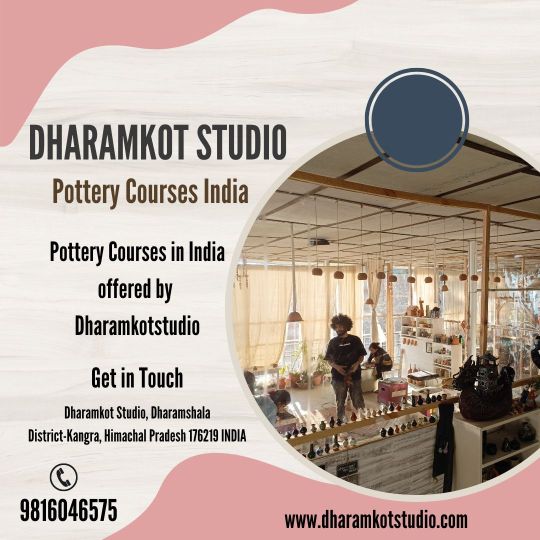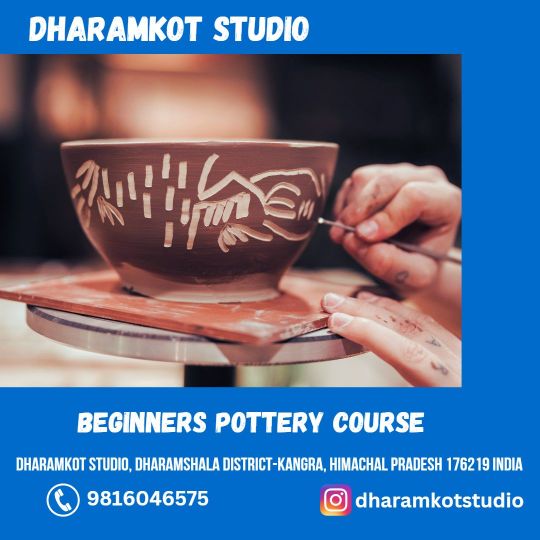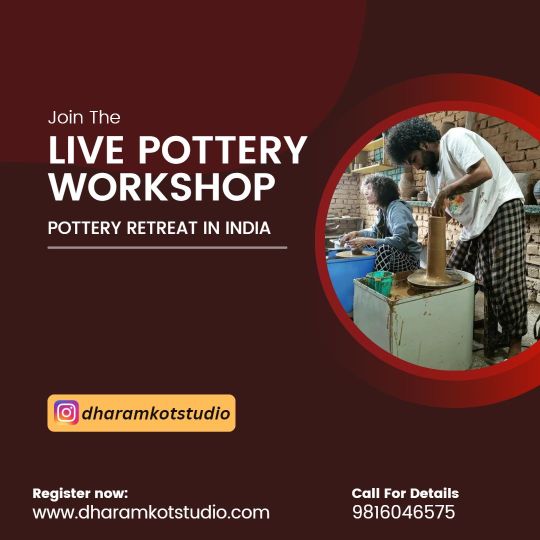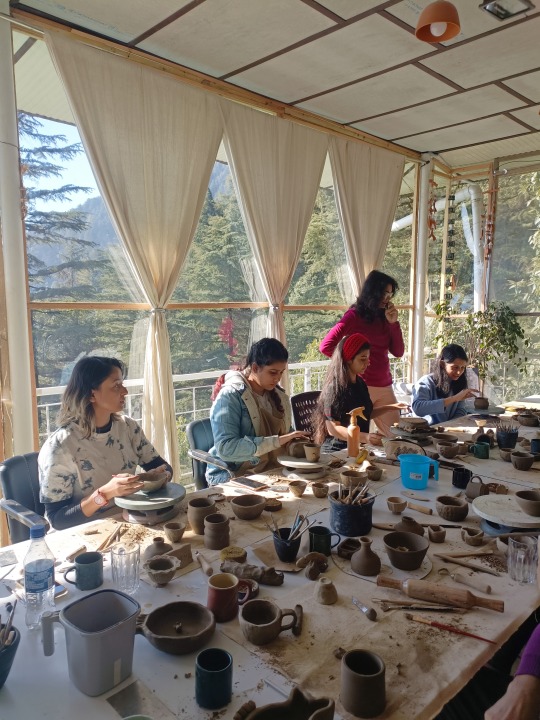Text
Making Magic with Mud: A Journey through Beginners Pottery at Dharamkot Studio
Pottery is a form of art that has been around for thousands of years, and yet it remains a beloved and fascinating craft for millions of people all over the world. The Beginners Pottery Course offered at Dharamkot Studio is an excellent opportunity to learn the basics of this artistic medium and develop new skills that will last a lifetime. This course is designed for individuals who have little or no prior experience with pottery and want to explore this medium in a relaxed and supportive environment.
The Beginners Pottery Course offers a perfect blend of theory and practice. The students are introduced to the basic concepts of pottery, such as clay types, glazes, and firing techniques, before they start practicing on the wheel. The instructors are professionals with years of experience in the field, and they provide ample guidance and support to help students create beautiful pieces of art. The course is divided into several sessions, each focusing on a specific technique such as making a pinch pot, coiling technique, slab work, and throwing on the wheel. By the end of the course, students have the knowledge and skill to create a wide variety of finished products.
The course takes place at Dharamkot Studio, a spacious and well-lit facility surrounded by the stunning Himalayan mountains. The studio is a calm and serene space that fosters creativity and artistic expression. The instructors provide all the necessary materials and tools, so students can focus on their craft without worrying about the logistics. The studio also offers access to firing kilns and other specialized tools required to produce high-quality pottery.
One of the most significant benefits of the Beginners Pottery Course is the opportunity to work on the pottery wheel. While this technique can be challenging for beginners, it also provides an unparalleled sense of satisfaction and accomplishment. Students learn how to center the clay on the wheel and manipulate it to create different shapes, from bowls and cups to more complex items such as vases and teapots. With proper guidance and practice, students can develop their personal style and create their signature pieces.
The Beginners Pottery Course at Dharamkot Studio is not only an excellent opportunity to learn pottery but also a chance to connect with like-minded individuals who share an interest in art and creativity. The studio environment provides a supportive and collaborative atmosphere, and students can learn from each other's experiences. These interactions often lead to newfound friendships and a sense of community, which can be incredibly rewarding.
In conclusion, the Beginners Pottery Course offered at Dharamkot Studio is an excellent opportunity for individuals who want to explore the world of pottery. The course offers a perfect balance of theory and practical work, led by experienced instructors and set in a beautiful and peaceful environment. Students develop a wide range of skills and techniques, including the pottery wheel, and learn how to create unique pieces of art. Additionally, the course provides a chance to connect with other aspiring artists and create a sense of community. Whether one wants to develop a new hobby, explore art or simply try something new, the Beginners Pottery Course provides the perfect opportunity to do so.

0 notes
Text
Jumpstart Your Creativity: Strategies for Taking Effective Creative Breaks
Taking creative breaks in mountains is an excellent way to rejuvenate your mind and body, draw inspiration from nature, and find innovative solutions to real-life problems. But to make the most of your creative adventure and come back fresh and energized, you need to plan and execute your breaks strategically. Here are some strategies for taking effective creative breaks in mountains at Dharamkot Studio Dharamshala that will help you maximize your creativity, relaxation, and enjoyment.
Firstly, plan your trip in advance and choose the right time, location, and duration based on your preferences, goals, and physical fitness. Mountains offer a range of activities such as hiking, camping, skiing, and exploring, so identify what interests you and what you want to achieve during your break. Decide if you want to go solo or with a group, and if you need to hire a guide or rent equipment. Consider the weather, accommodation, and transportation options and make reservations accordingly. A well-planned trip ensures that you have everything you need to make the most of your time in the mountains.
Secondly, disconnect from technology and the outside world as much as possible during your break. Turn off your phone, emails, and social media notifications, and focus on the present moment and your surroundings. Unplugging from the digital world not only reduces stress and anxiety but also allows you to connect with nature, appreciate beauty, and boost your imagination. Bring a journal, sketchpad, or camera to record your thoughts, impressions, and observations, and use them as prompts to brainstorm ideas and create something new. A digital detox can help you declutter your mind and recharge your creative batteries.
Thirdly, engage in physical activities that challenge you and provide pleasure without exhausting you. Mountains offer plenty of opportunities to hike, bike, swim, climb, and ski, and each activity exposes you to different terrains, landscapes, and weather conditions. Choose an activity that suits your fitness level and interests, but also pushes you out of your comfort zone and encourages you to be present and mindful. Exercise releases endorphins, reduces tension, and clears your head, so it can help you unleash your creativity and solve problems with ease.
Fourthly, nourish your body and soul with healthy, local, and seasonal foods that provide energy, nutrients, and pleasure without overindulging. Mountain cuisine often features fresh dairy products, meats, grains, and berries, as well as herbal drinks, teas, and soups that reflect the local culture and traditions. Sample the regional specialties, but also try to incorporate fresh fruits, vegetables, and water into your diet to stay hydrated and prevent fatigue. Eating mindfully and savoring the flavors, aromas, and textures of food can enhance your sensory experience and fuel your creativity.

#creative retreat#art retreat#pottery retreat#pottery workshop#art retreat dharamshala#creative place in dharamshala
0 notes
Text
Discover Your Inner Creativity with the Best Art Workshops in Dharamshala
Dharamshala, a beautiful hill station in the Indian state of Himachal Pradesh, is not only known for its stunning natural beauty and vibrant Tibetan culture but also for its thriving art scene. Here are some of the best art workshops in Dharamshala for those looking to discover their inner creativity:
Dharamkot Pottery Studio & Art Retreat: Dharamkot Pottery Studio & Art Retreat offers an idyllic and peaceful getaway for art enthusiasts, especially those interested in pottery. Situated in the picturesque town of Dharamkot within the Himalayan foothills, this studio provides sculpting classes by professional artists that instruct beginners and experts alike. The retreat helps visitors to surround themselves with natural beauty while creating unique and fulfilling pieces of art. The tranquil atmosphere allows folks to disconnect from their daily routine entirely, making it a perfect environment to tap into your creative side fully. Moreover, the staff at Dharamkot Pottery Studio & Art Retreat are gracious and helpful hosts who make sure guests leave with unforgettable memories and fantastic creations as a reminder of their retreat experience.
Tushita Art School: Tushita Art School is a well-known art school in Dharamshala that offers courses in painting, drawing, sculpture, and printmaking. The school is run by professional artists who teach various techniques and styles of art.
Norbulingka Institute: The Norbulingka Institute is a cultural and educational center that offers workshops in traditional Tibetan art forms such as thangka painting, wood carving, and metal sculpture. The institute also offers courses in contemporary art forms such as photography, painting, and ceramics.
Kangra Arts Promotion Society: The Kangra Arts Promotion Society is a non-profit organization that aims to promote traditional art forms of the Kangra region. The society offers workshops in Kangra miniature paintings, pottery, and embroidery.
Himalayan Film School: The Himalayan Film School offers courses in filmmaking, animation, and graphic design. The school is run by professionals in the field and offers hands-on experience in all aspects of filmmaking.
Potala Tibetan Art School: The Potala Tibetan Art School offers courses in traditional Tibetan art forms such as thangka painting, sculpture, and embroidery. The school is run by professional Tibetan artists who teach the techniques and styles of these traditional art forms.
Dharamshala is a hub for art and creativity, and these workshops offer a great opportunity for visitors to explore their inner artist and learn new skills from professionals in the field.

0 notes
Text
Off the Wheel Daily Hustle and Into the Potters Arena: Learn Pottery in India
Pottery is a beautiful art form that immerses you in endless creativity and calms your mind. Dharamkot Studio, located in the scenic Himalayan town of Dharamshala, India, offers an ideal space to learn pottery from skilled craftsmen and designers.
Pottery has a long and storied history in India, and Dharamkot Studio is a torchbearer of this tradition. We offer classes for beginners, intermediate and advanced level potters. Here, one can learn to create various pottery forms like bowls, mugs, teaspoons, plates, vases, pitchers, and more. The studio uses a variety of techniques, ranging from hand-building, wheel-throwing to glazing and firing.
The classes comprise of small groups, ensuring that each participant receives individual attention and guidance. The environment is conducive to learning, and there is ample time for practical work as well as discussions and demonstrations.
Learning pottery is a therapeutic process that stimulates the brain and helps in stress relief. At our studio, the learning experience is enhanced by the tranquil surroundings of the Himalayas, and the relaxed pace of life(also known as Slow or Mindful living)
In addition to classes, Dharamkot Studio also offers residencies for artists and craftspeople, giving them an opportunity to learn and practice pottery in a supportive and inspiring environment.
On the outskirts of Dharamshala, this location provides a unique cultural experience, with nearby excursions to temples, waterfalls, and markets. Studio participants can stay in one of the local home-stays, giving them an opportunity to immerse themselves in the local culture and food.
In conclusion, Dharamkot Studio provides an excellent opportunity to learn pottery and immerse oneself in India's rich pottery tradition. With expert guidance, a supportive learning environment, and a stunning location, this experience is one that is sure to leave a lasting impression. Join us at the studio, and let your creative spirit soar!

0 notes
Text
Discover India’s Ceramic Culture with Pottery Courses
India is home to many centuries-old cultures, traditions, and art forms, including its vibrant ceramic culture. With Pottery courses emerging in many states like Himachal Pradesh, the prospects for embracing and preserving this ancient craft has never been brighter. Through its workshops and hands-on classes, budding artisans throughout the country can garner a greater appreciation for the art of ceramics.
India has a long and varied history of ceramic craftsmanship. It dates back at least 4,000 years to the Harappan civilization, which is credited with the invention of pottery kilns used for firing glazed and unglazed ceramics. During the Mughal period, potters from all over the country converged in Faizabad, the late 17th century capital of the empire, and produced some of the most beautiful and intricate works of this art form.
Today, Indian ceramics are used in many areas of life, including the production of dishes, vessels, furniture, and figurines. It is also a popular choice for decorative items and statues due to its deep symbolism and history of ornamentation using motifs such as flowers, birds, and animals. Pottery courses offered in India by Dharamkot Studio offer a great opportunity to discover and learn more about this cultural heritage.
These classes usually encompass an introduction to the various techniques used in ceramics, such as rolling, throwing, carving, engraving, pattern work, and glazing. Participants may also be taught about the history, symbolism, and purpose of ceramic art, as well as the different types of clays and stains available, the firing process and how to identify the most appropriate type of pottery for a particular project. Through first-hand experience, students also learn about the craftsmanship, attention to detail and design that goes into every ceramic piece.
In addition to gaining technical knowledge, pottery courses provide an invaluable opportunity to observe and appreciate India's long-standing ceramic culture. Aspiring potters can witness first-hand the skill, craftsmanship, and creativity that goes into creating a piece. It also encourages an understanding of the centuries-old tradition and the various sources of inspiration that inform the craft.
Whether it's through an online program, a wandering artisan, or a professional art studio, India's ceramic culture can be explored, celebrated and preserved through pottery courses. By learning its various techniques, symbols, and process, participants in India can gain a deeper appreciation for one of India's most enduring art forms.
#pottery workshop#creative retreat#art retreat#Places to visit in dharmshala#Community studio#Pottery retreat in mountains#Learning pottery in India
0 notes
Text
Creative Expression Awaits - Your Introduction to Pottery
A complete pottery experience typically involves several steps, including preparing the clay, shaping the pottery, decorating it, and firing it. Here's a more detailed explanation of each step:
Preparing the Clay: The first step in making pottery is to prepare the clay. This can involve soaking and wedging the clay to remove any air bubbles, which can cause the pottery to crack during the firing process.
Shaping the Pottery: Once the clay has been prepared, the next step is to shape it into the desired form. This can be done using a variety of techniques, including hand-building, where the clay is shaped by hand, or wheel-throwing, where the clay is shaped on a potter's wheel.
Decorating the Pottery: After the pottery has been shaped, it can be decorated using a variety of techniques, such as glazing, which involves applying a layer of liquid clay to the surface, or slip trailing, where a thin line of clay is applied to the surface using a tool.
Firing the Pottery: The final step in the pottery-making process is firing the pottery. This involves heating the clay in a kiln to a high temperature, which causes it to harden and become durable. Different clays and glazes will require different firing temperatures and firing schedules.
After the pottery has been fired and cooled, it is ready to be used or displayed. The complete pottery experience can be both challenging and rewarding, as it requires a combination of creativity, technical skill, and patience to produce a finished piece. You can visit dharamkot studio for details and learn ancient pottery skills.

#Pottery in India#Indian pottery#Best pottery studio in India#Ceramic courses in India#Pottery workshop#dharamshala#Mcleodganj#Thing to do in dharamshala#artist#pottery#retreat#creative retreat
1 note
·
View note